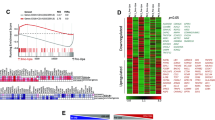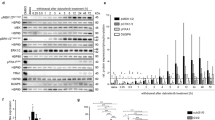Abstract
Macrophages play an important role in the regulation of malignant tumors. Although glioma contains abundance of macrophages, their role in apoptosis of glioma is not known. We stimulated macrophages with lipopolysaccharide and culture supernatants of activated macrophages were collected to treat glioma cells. The results showed that molecules released from activated macrophages significantly increased apoptosis of glioma via Fas/FasL and caspase-3 pathways. The level of soluble Fas did not appear to be involved in the mechanism responsible for apoptosis seen in this study, as its level was barely detected in both experimental and control groups. Two cytokines, TNFα and IFNγ, were significantly elevated in the supernatant obtained from the activated macrophages. Considering an important role of these two molecules in the induction of apoptosis mediated by the Fas/FasL system, the present data suggested that TNFα and IFNγ were the main molecules to trigger the cascade of apoptotic reactions in glioma cells. In conclusion, the present study indicates that molecules released from the activated macrophages provide significant signals to stimulate the expression of Fas/FasL and caspase-3, which function to induce apoptosis in glioma cells.
Similar content being viewed by others
References
Shinoura N, Muramatsu Y, Yoshida Y, Asai A, Kirino T, Hamada H: Adenovirus-mediated transfer of caspase-3 with Fas ligand induces drastic apoptosis in U-373MG glioma cells. Exp Cell Res 256: 423-433, 2000
Sasaki M, Plate KH: Gene therapy of malignant glioma: recent advances in experimental and clinical studies. Ann Oncol 9: 1155-1166, 1998
Roth W, Grimmel C, Rieger L, Strik H, Takayama S, Krajewski S, Meyermann R, Dichgans J, Reed JC, Weller M: Bag-1 and Bcl-2 gene transfer in malignant glioma: modulation of cell cycle regulation and apoptosis. Brain Pathol 10: 223-234, 2000
Weller M, Kleihues P, Dichgans J, Ohgaki H: CD95 ligand: lethal weapon against malignant glioma? Brain Pathol 8: 285-293, 1998
Ben-Hur H, Gurevich P, Ben-Arie A, Huszar M, Berman V, Tendler Y, Tchanishev R, Mor G, Gershon S, Zusman I: Apoptosis and apoptosis-related proteins (Fas, Fas ligand, Bcl-2, p53) in macrophages of human ovarian epithelial tumors. Eur J Gynaecol Oncol 21: 141-145, 2000
Wang SY, Hsu ML, Hsu HC, Tzeng CH, Lee SS, Shiao MS, Ho CK: The anti-tumor effect of Ganoderma lucidum is mediated by cytokines released from activated macrophages and T lymphocytes. Int J Cancer 70: 699-705, 1997
Ono M, Torisu H, Fukushi J, Nishie A, Kuwano M: Biological implications of macrophage infiltration in human tumor angiogenesis. Cancer Chemother Pharmacol 43 (Suppl): S69-S71, 1999
Morantz RA, Wood GW, Foster M, Clark M, Gollahon K: Macrophages in experimental and human brain tumors. Part 2: studies of the macrophage content of human brain tumors. J Neurosurgery 50: 305-311, 1979
Tzeng JJ, Barth RF, Orosz CG: Quantitation of gliomareactive cytolytic T lymphocyte precursors by means of limiting dilution analysis. J Immunol Methods 146: 177-184, 1992
Tzeng JJ, Barth RF, Orosz CG, James SM: Phenotype and functional activity of tumor-infiltrating lymphocytes isolated from immunogenic and nonimmunogenic rat brain tumors. Cancer Res 51: 2373-2378, 1991
Bouwens L, Baekeland M, Wisse E: Cytokinetic analysis of the expanding Kupffer-cell population in rat liver. Cell Tissue Kinetics 19: 217-226, 1986
Jones EA, Summerfield JA: Kupffer cells. In: Arias IM, Jakoby WB, Popper H, Schachter D, Shafritz DA (eds) The Liver: Biology and Pathobiology. 2nd edn. Raven Press, New York, 1988, pp 683-704
Olynyk JK, Clarke SL: Isolation and primary culture of rat Kupffer cells. J Gastroenterol Hepatol 13: 842-845, 1998
Alpini G, Phillips JO, Vroman B, LaRusso NF: Recent advances in the isolation of liver cells. Hepatol 20: 494-514, 1994
Dijkstra CD, Dopp EA, Joling P, Kraal G: The heterogeneity of mononuclear phagocytes in lymphoid organs: distinct macrophage subpopulations in the rat recognized by monoclonal antibodies ED1, ED2 and ED3. Immunol 54: 589-599, 1985
Casciola-Rosen L, Nicholson DW, Chong T, Rowan KR, Thornberry NA, Miller DK, Rosen A: Apopain/CPP32 cleaves proteins that are essential for cellular repair: a fundamental principle of apoptotic death. J Exp Med 183: 1957-1964, 1996
Midis GP, Shen Y, Owen-Schaub LB: Elevated soluble Fas (sFas) levels in nonhematopoietic human malignancy. Cancer Res 56: 3870-3874, 1996
Mantovani A, Bottazzi B, Colotta F, Sozzani S, Ruco L: The origin and function of tumor-associated macrophages. Immunol Today 13: 265-270, 1992
Weller M, Frei K, Groscurth P, Krammer PH, Yonekawa Y, Fontana A: Anti-Fas/APO-1 antibody-mediated apoptosis of cultured human glioma cells. Induction and modulation of sensitivity by cytokines. J Clin Invest 94: 954-964, 1994
Yang BC, Wang YS, Wang CH, Lin HH, Tang MJ, Yang TL: Transient apoptosis elicited by insulin in serum-starved glioma cells involves Fas/Fas-L and Bcl-2. Cell Biol Int 23: 533-540, 1999
Yount GL, Levine KS, Kuriyama H, Haas-Kogan DA, Israel MA: Fas (APO-1/CD95) signaling pathway is intact in radioresistant human glioma cells. Cancer Res 59: 1362-1365, 1999
Weller M, Kleihues P, Dichgans J, Ohgaki H: CD95 ligand: lethal weapon against malignant glioma? Brain Pathol 8: 285-293, 1998
Frei K, Ambar B, Adachi N, Yonekawa Y, Fontana A: Ex vivo malignant glioma cells are sensitive to Fas (CD95/APO-1) ligand-mediated apoptosis. J Neuroimmunol 87: 105-113, 1998
Shinoura N, Ohashi M, Yoshida Y, Kirino T, Asai A, Hashimoto M, Hamada H: Adenovirus-mediated overexpression of Fas induces apoptosis of gliomas. Cancer Gene Therapy 7: 224-232, 2000
Kawaguchi S, Mineta T, Ichinose M, Masuoka J, Shiraishi T, Tabuchi K, Rutka JT, Glick RP, Markert JM: Induction of apoptosis in glioma cells by recombinant human Fas ligand. Neurosurgery 46: 431-439, 2000
Ambar BB, Frei K, Malipiero U, Morelli AE, Castro MG, Lowenstein PR, Fontana A: Treatment of experimental glioma by administration of adenoviral vectors expressing Fas ligand. Human Gene Therapy 10: 1641-1648, 1999
Woo M, Hakem A, Elia AJ, Hakem R, Duncan GS, Patterson BJ, Mak TW: In vivo evidence that caspase-3 is required for Fas-mediated apoptosis of hepatocytes. J Immunol 163: 4909-4916, 1999
Hueber A, Winter S, Weller M: Chemotherapy primes malignant glioma cells for CD95 ligand-induced apoptosis up-stream of caspase-3 activation. Eur J Pharmacol 352: 111-115, 1998
Schlapbach R, Fontana A: Differential activity of Bcl-2 and ICE enzyme family protease inhibitors on Fas and puromycin-induced apoptosis of glioma cells. Biochim Biophy Acta 1359: 174-180, 1997
Xerri L, Palmerini F, Devilard E, Defrance T, Bouabdallah R, Hassoun J, Birg F: Frequent nuclear localization of ICAD and cytoplasmic co-expression of caspase-8 and caspase-3 in human lymphomas. J Pathol 192: 194-202, 2000
Weller M, Malipiero U, Aguzzi A, Reed JC, Fontana A: Protooncogene bcl-2 gene transfer abrogates Fas/APO-1 antibody-mediated apoptosis of human malignant glioma cells and confers resistance to chemotherapeutic drugs and therapeutic irradiation. J Clin Invest 95: 2633-2643, 1995
Weller M, Frei K, Groscurth P, Krammer PH, Yonekawa Y, Fontana A: Anti-Fas/APO-1 antibody-mediated apoptosis of cultured human glioma cells. Induction and modulation of sensitivity by cytokines. J Clin Invest 94: 954-964, 1994
Nishikawa M, Sato EF, Kuroki T, Utsumi K, Inoue M: Macrophage-derived nitric oxide induces apoptosis of rat hepatoma cells in vivo. Hepatol 28: 1474-1480, 1998
Sawada M, Nakashima S, Kiyono T, Nakagawa M, Yamada J, Yamakawa H, Banno Y, Shinoda J, Nishimura Y, Nozawa Y, Sakai N: p53 regulates ceramide formation by neutral sphingomyelinase through reactive oxygen species in human glioma cells. Oncogene 20: 1368-1378, 2001
Amoroso S, Tortiglione A, Secondo A, Catalano A, Montagnani S, Di Renzo G, Annunziato L: Sodium nitroprusside prevents chemical hypoxia-induced cell death through iron ions stimulating the activity of the Na+-Ca2+ exchanger in C6 glioma cells. J Neurochem 74: 1505-1513
Mizuno M, Yoshida J: Tumor necrosis factor-alpha gene transfer augments anti-Fas antibody-mediated apoptosis in human glioma cells. Jap J Cancer Res 87: 543-547, 1996
Munder M, Mallo M, Eichmann K, Modolell M: Murine macrophages secrete interferon gamma upon combined stimulation with interleukin (IL)-12 and IL-18: a novel pathway of autocrine macrophage activation. J Exp Med 87: 2103-2108, 1998
Badie B, Schartner J, Vorpahl J, Preston K: Interferongamma induces apoptosis and augments the expression of Fas and Fas ligand by microglia in vitro. Exp Neurol 162: 290-296, 2000
Dai C, Krantz SB: Interferon gamma induces upregulation and activation of caspases 1, 3, and 8 to produce apoptosis in human erythroid progenitor cells. Blood 93: 3309-3316, 1999
Chen M-C, Hsu T-L, Luh T-Y, Hsieh S-L: Overexpression of Bcl-2 enhances LIGHT-and interferon-gamma-mediated apoptosis in Hep3BT2 cells. J Biol Chem 275: 38794-38801, 2000
Kanno H, Hattori S, Sato H, Murata H, Huang FH, Hayashi A, Suzuki N, Yamamoto I, Kawamoto S, Minami M, Miyatake S, Shuin T, Kaplitt MG: Experimental gene therapy against subcutaneously implanted glioma with a herpes simplex virus-defective vector expressing interferon-gamma. Cancer Gene Therapy 6: 147-154, 1999
Tanigawa K, Craig RA, Stoolman LM, Chang AE: Effects of tumor necrosis factor-alpha on the in vitro maturation of tumor-reactive effector T cells. J Immunother 23: 528-535, 2000
Romieu R, Lacabanne V, Kayibanda M, Antoine B, Bennoun M, Chouaib S, Guillet JG, Viguier M: Critical stages of tumor growth regulation in transgenic mice harboring a hepatocellular carcinoma revealed by distinct patterns of tumor necrosis factor-alpha and transforming growth factor-beta mRNA production. Int Immunol 9: 1405-1413, 1997
Author information
Authors and Affiliations
Rights and permissions
About this article
Cite this article
Chen, G.G., Chun, Y.S., Chak, E.C. et al. Induction of Apoptosis in Glioma Cells by Molecules Released from Activated Macrophages. J Neurooncol 57, 179–186 (2002). https://doi.org/10.1023/A:1015763916020
Issue Date:
DOI: https://doi.org/10.1023/A:1015763916020




